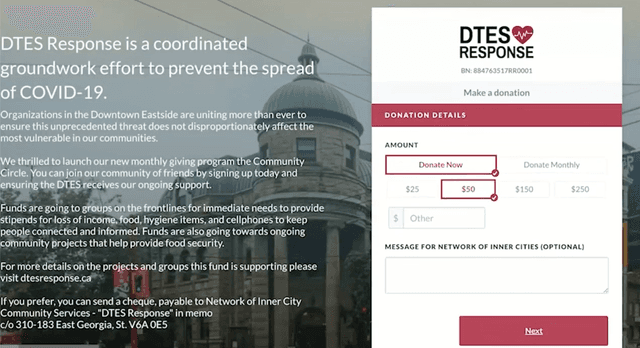Downtown East Side Response: Raising money for the community during coronavirus
- Exhibited by
- Tamara Rahmani
- Added
- April 21, 2022
- Medium of Communication
- Online
- Target Audience
- All donors
- Type of Charity
- Community support
- Country of Origin
- Canada
- Date of first appearance
- March 2020
SOFII’s view
This campaign, presented at I Wish I’d Thought of That (IWITOT): The Americas 2021, is an example of impeccable fundraising; from the design of the website to the frequency of communications and thanking. It’s also shows how the Downtown East Side (DTES) Response Fund used the urgency of the coronavirus crisis to reiterate and reinvigorate the narrative around addressing historical issues faced by a vulnerable community. So, while the initial ask addressed a specific, coronavirus-enforced need, the long-term positive impact on this wonderful city would be massive.
Background
The poorest neighbourhood in Vancouver is the Downtown East Side, which is also sadly the poorest postal code in the whole of Canada. It has seen decades of issues with crime, homelessness, unaffordability, unemployment, and an opioid crisis that has been exacerbated by coronavirus.
At the start of the pandemic, it became very clear that the 15,000 people who live in the Downtown East Side were at risk of a massive community outbreak of Covid-19. Of those 15,000 people, 3,000 are homeless and 4,700 are at added risk, living in privately-run, single-occupancy hotel rooms.
Under these conditions, self-isolating and social distancing are extremely difficult. Tenants share bathrooms and do not always have access to soap, making regular handwashing impossible. They also do not have kitchens and soup kitchens at that time had been shut down, while food banks had very limited stock. So the community advocates named their project the DTES Response, or Downtown East Side Response. What was initially intended to be a stop-gap plan of soap deliveries became a hugely successful fundraising initiative.
Creator / originator
DTES Response
Special characteristics
The DTES team started their goal very small. They knew that frequent handwashing was one of the most important ways to combat coronavirus. However, how do you wash your hands if you don’t have soap? The best way to raise money for and distribute soap was by activating the amazing frontline organisations in the area. These non-profits were at risk of having to close down because of the pandemic and this partnership really let them continue their critical work while they shared information, distributed resources and acted as mutual support with the DTES Response team.
As more needs emerged, like for food, hygiene products, stipends for loss of income and cell phones, the group decided to focus on online donations to grant out to their newly partnered organisations. This would eliminate complications with in-kind donations or cash gifts.
Merits
What they needed to facilitate the above was a website, an email signup service such as MailChimp, social media accounts, a fundraising back-end, a press release, and online donation platform. And they looked polished.
They had a very clear logo, a name, mission, and a professional-looking website that included a branded donation form. They also immediately released a press release that had a very clear call to action: coronavirus does disproportionately affect people on the Downtown East Side. They called on the media, making the most of the connections they had, and they repeated the same call to action on their platform and social networks. For them, repetition wasn’t a lack of creativity, but rather a way to reinstate urgency. They asked their supporters to spread the word, underlining that though restrictions prevented them from volunteering, getting information out could be just as effective. They focused on building their contact list, believing that good data is more valuable than a one-time donation. They sent a lot of emails and were always driving donors to their website and donation form; and they thanked their donors a lot. It took a lot of time for this small team, but it went a very long way.
All this repeated, month after month, allowed DTES Response to keep the momentum of initial urgency. And as I mentioned before, it renewed the awareness of pre-existing issues in the community and as a result government officials, philanthropists and people in the greater community are now more invested in the Downtown East Side community than before the pandemic started.
Influence / impact
I know that some of us in the fundraising sector were grappling with whether to hit the brakes or cautiously move forward with our work at the start of the pandemic. But this group has really shown that doubling down on the urgency and momentum of a crisis can actually bring about change to not only the issue at hand but also to pre-existing issues facing a community.
Results
The fund raised CA$400,000 in the first six months of the pandemic, which they granted out to 29 frontline non-profit groups in the area. They also secured 70 monthly donors, two community long-term projects and a contact list of over 2,500 people. But almost most importantly, their success is in the fact that they rebuilt capacity for people on the frontlines and reinvigorated awareness about the pre-existing crises in the neighbourhood.
You can watch Tamara’s presentation at IWITOT Americas 2021 here:
IMAGES: ©DTES Response, Tamara Rahmani or as cited individually.
 View original image
View original image

 View original image
View original image
 View original image
View original image
















